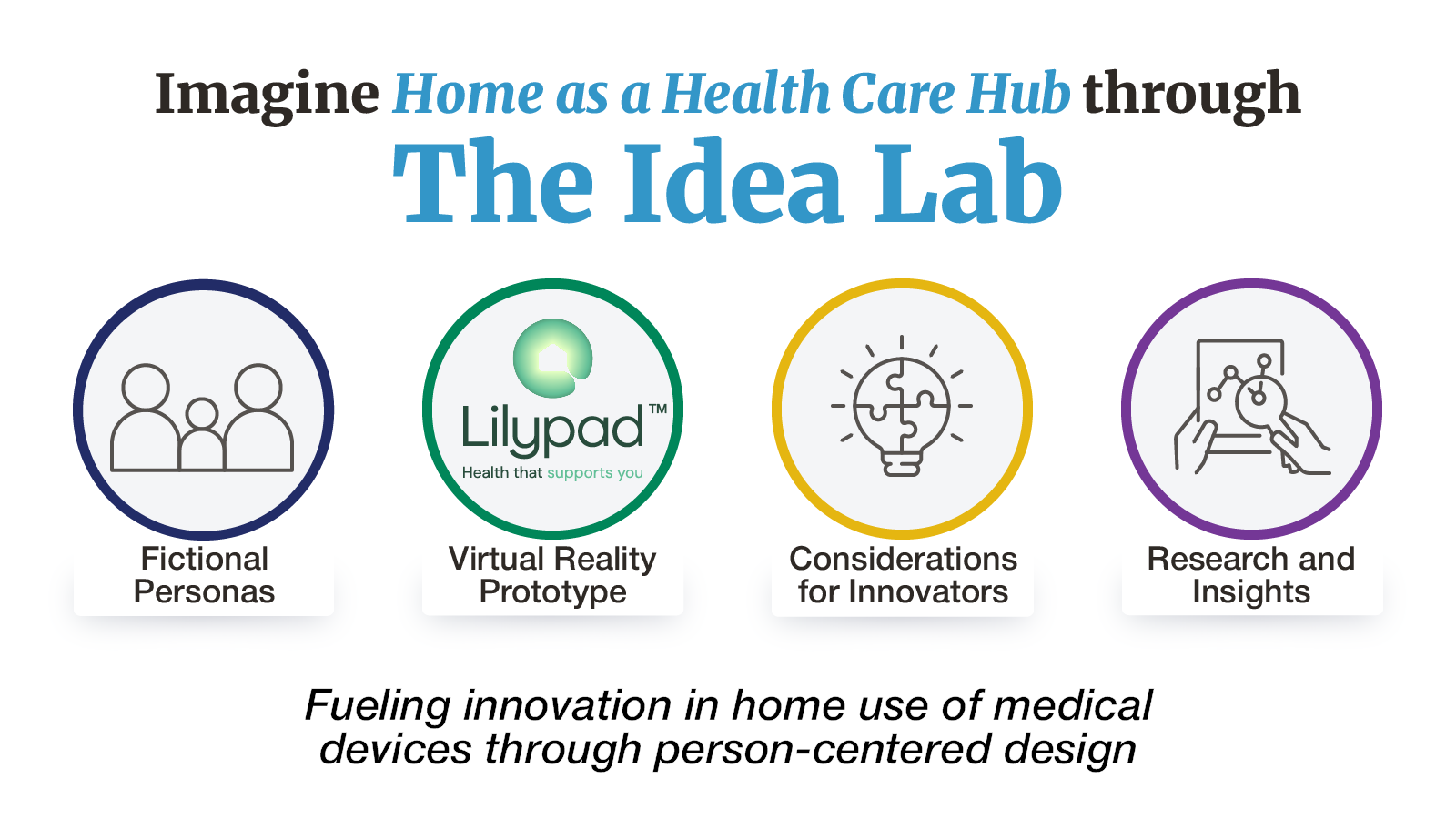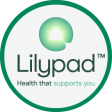Idea Lab
A key component of the Home as a Health Care Hub initiative is the creation of an Idea Lab for developers to create new solutions, visualize how their medical devices may fit into the lifestyles and homes of people as well as integrate well with other health technologies. These medical devices could serve purposes of prevention, diagnosis, treatment, rehabilitation, and monitoring. The FDA chose people living with diabetes as a test case given the prevalence and burden of disease, the importance of medical devices and lifestyle in managing the condition and preventing comorbidities, and the active patient organizations and provider groups that are well-positioned to contribute to solutioning.
The Home as a Health Care Hub initiative began with a comprehensive literature review across four domains: clinical aspects, technology, housing design, and affordable housing. Input was received from subject matter experts and representatives of patient organizations, professional societies, medical device and consumer technology developers, and regulators. This literature review was assimilated into an overview of the current state of established and emerging diabetes health technologies used at home, home design considerations needed for the inclusion of these technologies in the home, and home design conditions beyond home-use of health technologies. This overview was validated and enhanced based on input from three constituencies: individuals with diabetes and their care partners, including some with health access constraints; medical device and consumer technology developers (including those with experience developing wearables and home use devices); and health care providers with experience providing care to individuals living with diabetes. The team also obtained insights from visiting two affordable housing sites. Insights from the discovery phase were synthesized into core health needs, a spectrum of user needs, technology considerations, home design conditions, and key takeaways.
While the Idea Lab focuses on diabetes as a test case, the Home as a Health Care Hub initiative is intended to catalyze solutions supporting prevention, wellness, and management of a variety of chronic diseases and other health conditions.
Explore the Idea Lab
We are developing detailed, fictional personas to help you understand how people with diabetes manage everyday life – where they live, their lifestyle, and their medical needs. The personas incorporate a variety of information related to medical device use, caregiver support, daily activities, and more. Each persona reflects different situations that collectively cover a broad range of medical device use (for example, home hemodialysis, wound vacuum, glucometer, continuous glucose monitor, blood pressure monitor, etc.) observed with and expressed by real people living with diabetes during the discovery phase. To start, we’d like to introduce you to Sean Gomez.
You’re invited to visit a person’s home as they integrate currently available medical devices into their daily life. The Lilypad™ is a free software that allows users to virtually enter the world of people living with diabetes in affordable housing. This virtual environment allows you to walk through and gain insights on the real world challenges and constraints people face as they manage their health care at home. Hopefully, this experience will help you design home-based medical technology that can support the delivery of care, wellness, and prevention.
The Lilypad™ is available for anyone with a compatible VR headset, for example Meta Quest 3, along with its wireless handheld controllers and tethering cable (USB-C) provided by the manufacturer. Users can also download the VR files and bring their own innovations into the space for usability and other evaluations.
The Lilypad™ VR experience has been designed to run on a computer with these minimum recommended specifications:
Computer
- Processor: 24 Cores, 32 Threads, 5.8GHz Max Frequency
- Basis of Design: 14th Gen Intel® Core™ i9 14900HX
- Graphics: 16,000 Cores, 24GB GDDR6X VRAM, 2.23GHz Base Clock
- Basis of Design: NVIDIA GeForce RTX 4090
- Memory: 64GB DDR5 5200 MT/s, non-ECC, dual channel
- Display: 1920x1080
- Operating System Basis of Design: Windows 10
- Free space on Hard Drive: at least 5GB
Software
The following software is required to run the VR experience and must be installed on a PC.
- Windows 10 or later
- Manufacturer-provided VR Headset software: Meta Quest Link
- Steam and Steam VR
Technical Guide
Learn about the technical requirements, processes for setup, and steps required to run the Lilypad™ VR experience.
Warning
There may be adverse events associated with the use of VR. Please refer to the safety warnings associated with the specific AR/VR/MR headset used.
Based on research and expert input from the discovery phase, innovators may wish to consider the questions below to help support meaningful innovation of medical devices that can enable people to optimize their health and wellness where they live.
- For Medical Device Developers
- Can the device safely and effectively operate in homes that do not have a reliable internet source or who may limitations in their power or water supply?
- Can the device safely and effectively operate in homes that do not have favorable lighting, acoustics, ergonomic, and air quality conditions?
- Will the device, with all accessories and supplies, fit into a person’s home discreetly so as to maintain privacy and avoid constant reminders of the burden of managing their condition, particularly in spaces used for social gatherings?
- Can the device help people do more with fewer interfaces?
- Can the device be incorporated into other objects of daily life that a person is already using?
- Can the device seamlessly connect to other objects and activities of daily living and the spaces where they happen?
- Can the device be integrated into the home in a way that it can support the person’s health while encouraging their active engagement? Can the device support the person’s health with minimal added participatory burden for them, i.e., through their more “passive” participation?
- Is the device cybersecure? And does it allow the person to choose if and with whom their information is shared?
- Can the device support the capture of high-quality real-world data to contribute to a better understanding of device performance?
- Can the device be used correctly by people of varying physical, cognitive, sensory, and (digital- and health-specific) literacy functioning?
- For Health Care Providers prescribing home care, including use of medical devices
- Does the person’s home have a sufficiently reliable source for power, internet, and water supply to support safe and correct use of medical devices?
- Does the person’s home have lighting, acoustics, ergonomics, and air quality conditions favorable for home care including safe and proper use of medical devices?
- Does the person’s home have appropriate space for conducting the range of home care functions you are prescribing, including adequate storage for all medical supplies?
- Do you know whether any modifications to the person’s home environment may be needed to adequately support the required care needs?
- Do you know whether the person has adequate digital and health literacy to properly use the prescribed medical device(s)?
- Does the person’s home allow for care to be delivered with appropriate privacy and minimum disruption to their daily lives?
- For Architects, Housing Developers, and Designers creating homes that support use of medical devices
- Is there reliable, consistent access to sufficient power, water supply and quality, and internet to support safe and proper use of medical devices?
- Does the orientation, structure, and layout allow for good lighting and ventilation?
- Are the interiors designed with good acoustics, easy to reach storage, minimum barriers, and easily cleanable surfaces?
- Is there appropriate space for conducting a range of home care functions, including adequate storage for all medical supplies and clutter free circulation?
- Is the home designed in a barrier-free and flexible way where zones for clinical care, self-care, work, activity, and social connection can be created when needed?
- Is the space appropriate for care to be delivered to the home by health providers and allied professionals in an easy and accessible way?
Here’s where you’ll find insight on the Home as a Health Care initiative and the latest research. Additional information from the discovery phase will be added over time.





